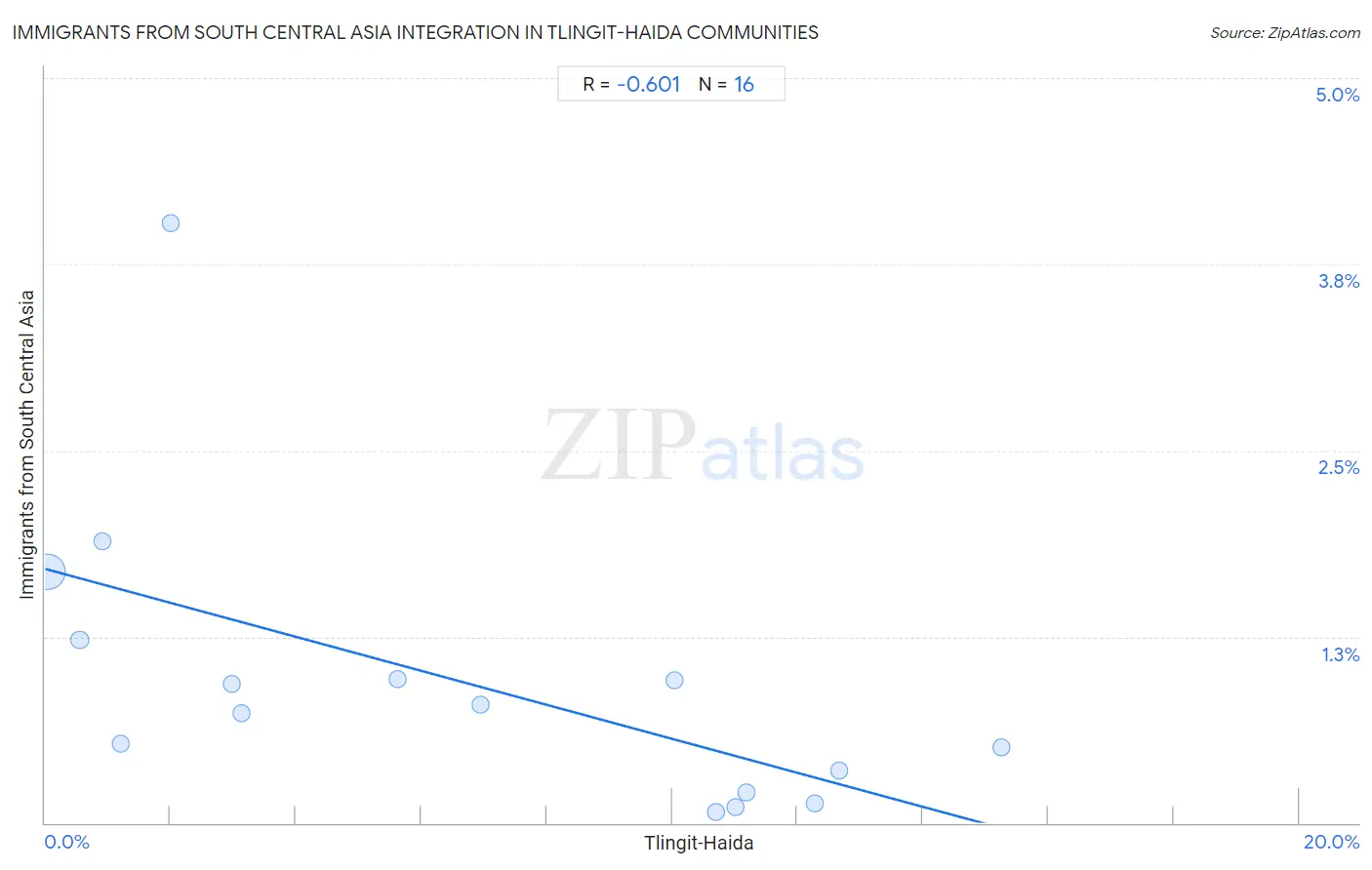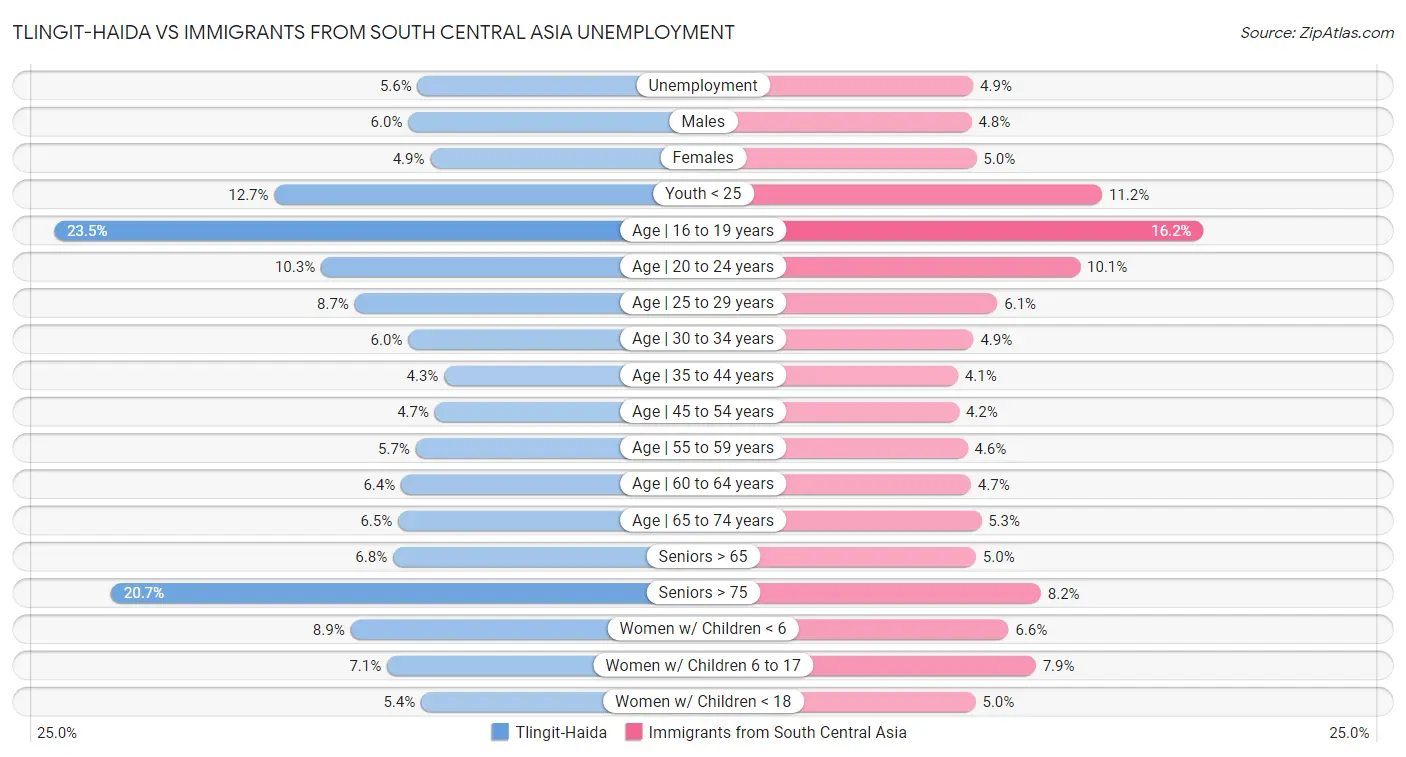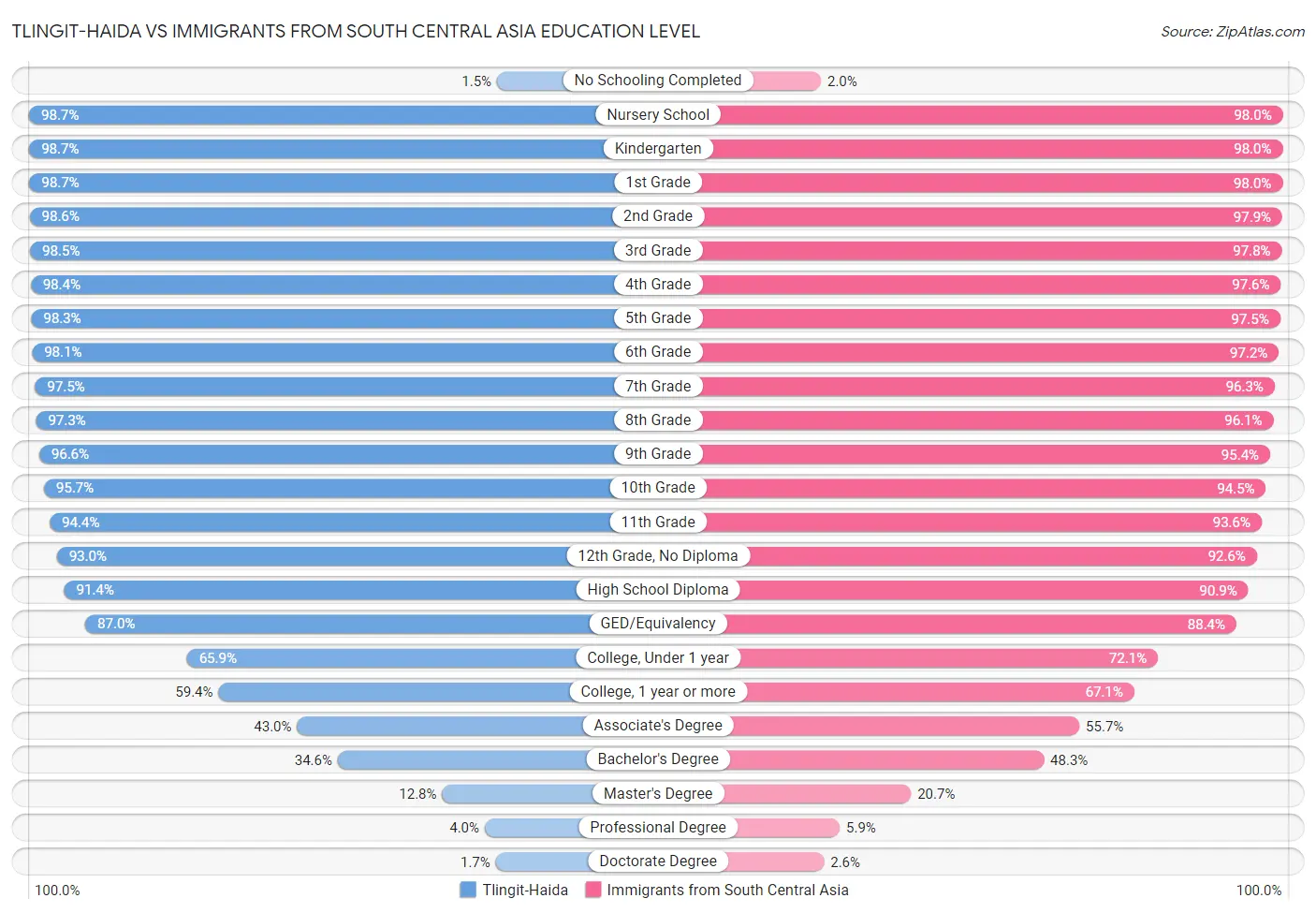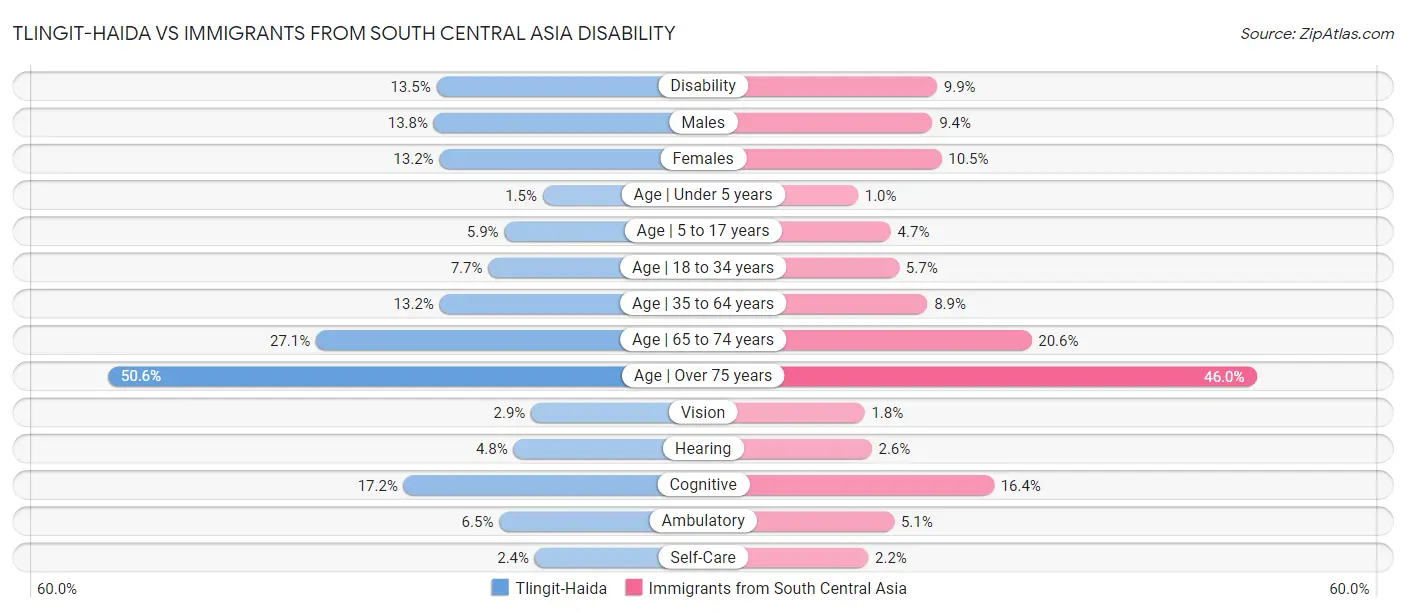Tlingit-Haida vs Immigrants from South Central Asia Community Comparison
COMPARE
Tlingit-Haida
Immigrants from South Central Asia
Social Comparison
Social Comparison
Tlingit-Haida
Immigrants from South Central Asia
5,201
SOCIAL INDEX
49.5/ 100
SOCIAL RATING
182nd/ 347
SOCIAL RANK
9,859
SOCIAL INDEX
96.0/ 100
SOCIAL RATING
6th/ 347
SOCIAL RANK
Immigrants from South Central Asia Integration in Tlingit-Haida Communities
The statistical analysis conducted on geographies consisting of 59,097,217 people shows a significant negative correlation between the proportion of Immigrants from South Central Asia within Tlingit-Haida communities in the United States with a correlation coefficient (R) of -0.601. On average, for every 1% (one percent) increase in Tlingit-Haida within a typical geography, there is a decrease of 0.114% in Immigrants from South Central Asia. To illustrate, in a geography comprising of 100,000 individuals, a rise of 1,000 Tlingit-Haida corresponds to a decrease of 114.1 Immigrants from South Central Asia.

Tlingit-Haida vs Immigrants from South Central Asia Income
When considering income, the most significant differences between Tlingit-Haida and Immigrants from South Central Asia communities in the United States are seen in median male earnings ($52,409 compared to $68,960, a difference of 31.6%), householder income ages 45 - 64 years ($97,417 compared to $124,188, a difference of 27.5%), and median household income ($83,968 compared to $106,057, a difference of 26.3%). Conversely, both communities are more comparable in terms of householder income under 25 years ($55,914 compared to $57,818, a difference of 3.4%), householder income over 65 years ($62,922 compared to $70,103, a difference of 11.4%), and median female earnings ($39,513 compared to $46,324, a difference of 17.2%).

| Income Metric | Tlingit-Haida | Immigrants from South Central Asia |
| Per Capita Income | Average $43,516 | Exceptional $52,660 |
| Median Family Income | Fair $101,092 | Exceptional $125,956 |
| Median Household Income | Fair $83,968 | Exceptional $106,057 |
| Median Earnings | Fair $45,468 | Exceptional $57,114 |
| Median Male Earnings | Poor $52,409 | Exceptional $68,960 |
| Median Female Earnings | Average $39,513 | Exceptional $46,324 |
| Householder Age | Under 25 years | Exceptional $55,914 | Exceptional $57,818 |
| Householder Age | 25 - 44 years | Fair $92,987 | Exceptional $116,626 |
| Householder Age | 45 - 64 years | Poor $97,417 | Exceptional $124,188 |
| Householder Age | Over 65 years | Excellent $62,922 | Exceptional $70,103 |
| Wage/Income Gap | Exceptional 24.0% | Tragic 29.3% |
Tlingit-Haida vs Immigrants from South Central Asia Poverty
When considering poverty, the most significant differences between Tlingit-Haida and Immigrants from South Central Asia communities in the United States are seen in receiving food stamps (11.6% compared to 8.8%, a difference of 31.2%), female poverty among 25-34 year olds (13.8% compared to 10.8%, a difference of 28.3%), and female poverty among 18-24 year olds (22.0% compared to 17.6%, a difference of 25.1%). Conversely, both communities are more comparable in terms of married-couple family poverty (4.4% compared to 4.3%, a difference of 1.6%), single father poverty (15.3% compared to 14.5%, a difference of 5.8%), and single male poverty (11.6% compared to 10.9%, a difference of 6.2%).

| Poverty Metric | Tlingit-Haida | Immigrants from South Central Asia |
| Poverty | Excellent 11.7% | Exceptional 10.2% |
| Families | Exceptional 8.0% | Exceptional 7.2% |
| Males | Good 10.9% | Exceptional 9.3% |
| Females | Exceptional 12.5% | Exceptional 11.1% |
| Females 18 to 24 years | Tragic 22.0% | Exceptional 17.6% |
| Females 25 to 34 years | Fair 13.8% | Exceptional 10.8% |
| Children Under 5 years | Exceptional 15.9% | Exceptional 13.3% |
| Children Under 16 years | Exceptional 14.9% | Exceptional 12.5% |
| Boys Under 16 years | Exceptional 15.3% | Exceptional 12.7% |
| Girls Under 16 years | Exceptional 14.7% | Exceptional 12.7% |
| Single Males | Exceptional 11.6% | Exceptional 10.9% |
| Single Females | Tragic 21.9% | Exceptional 17.8% |
| Single Fathers | Exceptional 15.3% | Exceptional 14.5% |
| Single Mothers | Tragic 30.9% | Exceptional 25.3% |
| Married Couples | Exceptional 4.4% | Exceptional 4.3% |
| Seniors Over 65 years | Exceptional 8.3% | Exceptional 9.7% |
| Seniors Over 75 years | Exceptional 9.7% | Exceptional 11.4% |
| Receiving Food Stamps | Average 11.6% | Exceptional 8.8% |
Tlingit-Haida vs Immigrants from South Central Asia Unemployment
When considering unemployment, the most significant differences between Tlingit-Haida and Immigrants from South Central Asia communities in the United States are seen in unemployment among seniors over 75 years (20.7% compared to 8.2%, a difference of 152.8%), unemployment among ages 16 to 19 years (23.5% compared to 16.2%, a difference of 45.0%), and unemployment among ages 25 to 29 years (8.7% compared to 6.1%, a difference of 43.4%). Conversely, both communities are more comparable in terms of female unemployment (4.9% compared to 5.0%, a difference of 1.6%), unemployment among ages 20 to 24 years (10.3% compared to 10.1%, a difference of 2.0%), and unemployment among ages 35 to 44 years (4.3% compared to 4.1%, a difference of 3.7%).

| Unemployment Metric | Tlingit-Haida | Immigrants from South Central Asia |
| Unemployment | Tragic 5.6% | Exceptional 4.9% |
| Males | Tragic 6.0% | Exceptional 4.8% |
| Females | Exceptional 4.9% | Exceptional 5.0% |
| Youth < 25 | Tragic 12.7% | Exceptional 11.2% |
| Age | 16 to 19 years | Tragic 23.5% | Exceptional 16.2% |
| Age | 20 to 24 years | Fair 10.3% | Excellent 10.1% |
| Age | 25 to 29 years | Tragic 8.7% | Exceptional 6.1% |
| Age | 30 to 34 years | Tragic 6.0% | Exceptional 4.9% |
| Age | 35 to 44 years | Exceptional 4.3% | Exceptional 4.1% |
| Age | 45 to 54 years | Tragic 4.7% | Exceptional 4.2% |
| Age | 55 to 59 years | Tragic 5.7% | Exceptional 4.6% |
| Age | 60 to 64 years | Tragic 6.4% | Exceptional 4.7% |
| Age | 65 to 74 years | Tragic 6.5% | Exceptional 5.3% |
| Seniors > 65 | Tragic 6.8% | Exceptional 5.0% |
| Seniors > 75 | Tragic 20.7% | Exceptional 8.2% |
| Women w/ Children < 6 | Tragic 8.9% | Exceptional 6.6% |
| Women w/ Children 6 to 17 | Exceptional 7.1% | Exceptional 7.9% |
| Women w/ Children < 18 | Good 5.4% | Exceptional 5.0% |
Tlingit-Haida vs Immigrants from South Central Asia Labor Participation
When considering labor participation, the most significant differences between Tlingit-Haida and Immigrants from South Central Asia communities in the United States are seen in in labor force | age 16-19 (40.5% compared to 34.6%, a difference of 17.2%), in labor force | age 20-24 (77.9% compared to 74.0%, a difference of 5.3%), and in labor force | age 30-34 (82.3% compared to 85.1%, a difference of 3.4%). Conversely, both communities are more comparable in terms of in labor force | age 45-54 (83.9% compared to 84.0%, a difference of 0.13%), in labor force | age 25-29 (84.4% compared to 85.2%, a difference of 0.97%), and in labor force | age 20-64 (79.0% compared to 80.7%, a difference of 2.2%).

| Labor Participation Metric | Tlingit-Haida | Immigrants from South Central Asia |
| In Labor Force | Age > 16 | Excellent 65.5% | Exceptional 67.1% |
| In Labor Force | Age 20-64 | Tragic 79.0% | Exceptional 80.7% |
| In Labor Force | Age 16-19 | Exceptional 40.5% | Tragic 34.6% |
| In Labor Force | Age 20-24 | Exceptional 77.9% | Tragic 74.0% |
| In Labor Force | Age 25-29 | Poor 84.4% | Exceptional 85.2% |
| In Labor Force | Age 30-34 | Tragic 82.3% | Exceptional 85.1% |
| In Labor Force | Age 35-44 | Tragic 82.5% | Exceptional 85.0% |
| In Labor Force | Age 45-54 | Exceptional 83.9% | Exceptional 84.0% |
Tlingit-Haida vs Immigrants from South Central Asia Family Structure
When considering family structure, the most significant differences between Tlingit-Haida and Immigrants from South Central Asia communities in the United States are seen in single father households (2.7% compared to 2.0%, a difference of 36.1%), births to unmarried women (32.2% compared to 24.7%, a difference of 30.5%), and divorced or separated (13.2% compared to 10.4%, a difference of 26.4%). Conversely, both communities are more comparable in terms of average family size (3.16 compared to 3.23, a difference of 2.3%), single mother households (5.7% compared to 5.4%, a difference of 6.5%), and currently married (46.7% compared to 50.0%, a difference of 7.2%).

| Family Structure Metric | Tlingit-Haida | Immigrants from South Central Asia |
| Family Households | Tragic 61.6% | Exceptional 66.4% |
| Family Households with Children | Tragic 26.0% | Exceptional 30.0% |
| Married-couple Households | Tragic 45.1% | Exceptional 50.6% |
| Average Family Size | Tragic 3.16 | Average 3.23 |
| Single Father Households | Tragic 2.7% | Exceptional 2.0% |
| Single Mother Households | Exceptional 5.7% | Exceptional 5.4% |
| Currently Married | Average 46.7% | Exceptional 50.0% |
| Divorced or Separated | Tragic 13.2% | Exceptional 10.4% |
| Births to Unmarried Women | Fair 32.2% | Exceptional 24.7% |
Tlingit-Haida vs Immigrants from South Central Asia Vehicle Availability
When considering vehicle availability, the most significant differences between Tlingit-Haida and Immigrants from South Central Asia communities in the United States are seen in no vehicles in household (10.1% compared to 8.6%, a difference of 17.5%), 4 or more vehicles in household (6.8% compared to 6.1%, a difference of 11.9%), and 3 or more vehicles in household (19.9% compared to 19.3%, a difference of 2.8%). Conversely, both communities are more comparable in terms of 2 or more vehicles in household (55.8% compared to 56.6%, a difference of 1.5%), 1 or more vehicles in household (90.1% compared to 91.5%, a difference of 1.6%), and 3 or more vehicles in household (19.9% compared to 19.3%, a difference of 2.8%).

| Vehicle Availability Metric | Tlingit-Haida | Immigrants from South Central Asia |
| No Vehicles Available | Good 10.1% | Exceptional 8.6% |
| 1+ Vehicles Available | Good 90.1% | Exceptional 91.5% |
| 2+ Vehicles Available | Good 55.8% | Exceptional 56.6% |
| 3+ Vehicles Available | Good 19.9% | Fair 19.3% |
| 4+ Vehicles Available | Exceptional 6.8% | Fair 6.1% |
Tlingit-Haida vs Immigrants from South Central Asia Education Level
When considering education level, the most significant differences between Tlingit-Haida and Immigrants from South Central Asia communities in the United States are seen in master's degree (12.8% compared to 20.7%, a difference of 61.4%), doctorate degree (1.7% compared to 2.6%, a difference of 54.3%), and professional degree (4.0% compared to 5.9%, a difference of 47.8%). Conversely, both communities are more comparable in terms of 12th grade, no diploma (93.0% compared to 92.6%, a difference of 0.37%), high school diploma (91.4% compared to 90.9%, a difference of 0.64%), and nursery school (98.7% compared to 98.0%, a difference of 0.70%).

| Education Level Metric | Tlingit-Haida | Immigrants from South Central Asia |
| No Schooling Completed | Exceptional 1.5% | Good 2.0% |
| Nursery School | Exceptional 98.7% | Good 98.0% |
| Kindergarten | Exceptional 98.7% | Good 98.0% |
| 1st Grade | Exceptional 98.7% | Good 98.0% |
| 2nd Grade | Exceptional 98.6% | Good 97.9% |
| 3rd Grade | Exceptional 98.5% | Good 97.8% |
| 4th Grade | Exceptional 98.4% | Good 97.6% |
| 5th Grade | Exceptional 98.3% | Good 97.5% |
| 6th Grade | Exceptional 98.1% | Good 97.2% |
| 7th Grade | Exceptional 97.5% | Excellent 96.3% |
| 8th Grade | Exceptional 97.3% | Excellent 96.1% |
| 9th Grade | Exceptional 96.6% | Exceptional 95.4% |
| 10th Grade | Exceptional 95.7% | Exceptional 94.5% |
| 11th Grade | Exceptional 94.4% | Exceptional 93.6% |
| 12th Grade, No Diploma | Exceptional 93.0% | Exceptional 92.6% |
| High School Diploma | Exceptional 91.4% | Exceptional 90.9% |
| GED/Equivalency | Exceptional 87.0% | Exceptional 88.4% |
| College, Under 1 year | Good 65.9% | Exceptional 72.1% |
| College, 1 year or more | Average 59.4% | Exceptional 67.1% |
| Associate's Degree | Tragic 43.0% | Exceptional 55.7% |
| Bachelor's Degree | Tragic 34.6% | Exceptional 48.3% |
| Master's Degree | Tragic 12.8% | Exceptional 20.7% |
| Professional Degree | Tragic 4.0% | Exceptional 5.9% |
| Doctorate Degree | Poor 1.7% | Exceptional 2.6% |
Tlingit-Haida vs Immigrants from South Central Asia Disability
When considering disability, the most significant differences between Tlingit-Haida and Immigrants from South Central Asia communities in the United States are seen in hearing disability (4.8% compared to 2.6%, a difference of 87.6%), vision disability (2.9% compared to 1.8%, a difference of 59.9%), and disability age under 5 (1.5% compared to 1.0%, a difference of 50.1%). Conversely, both communities are more comparable in terms of cognitive disability (17.2% compared to 16.4%, a difference of 5.3%), disability age over 75 (50.6% compared to 46.0%, a difference of 10.0%), and self-care disability (2.4% compared to 2.2%, a difference of 11.1%).

| Disability Metric | Tlingit-Haida | Immigrants from South Central Asia |
| Disability | Tragic 13.5% | Exceptional 9.9% |
| Males | Tragic 13.8% | Exceptional 9.4% |
| Females | Tragic 13.2% | Exceptional 10.5% |
| Age | Under 5 years | Tragic 1.5% | Exceptional 1.0% |
| Age | 5 to 17 years | Tragic 5.9% | Exceptional 4.7% |
| Age | 18 to 34 years | Tragic 7.7% | Exceptional 5.7% |
| Age | 35 to 64 years | Tragic 13.2% | Exceptional 8.9% |
| Age | 65 to 74 years | Tragic 27.1% | Exceptional 20.6% |
| Age | Over 75 years | Tragic 50.6% | Exceptional 46.0% |
| Vision | Tragic 2.9% | Exceptional 1.8% |
| Hearing | Tragic 4.8% | Exceptional 2.6% |
| Cognitive | Average 17.2% | Exceptional 16.4% |
| Ambulatory | Tragic 6.5% | Exceptional 5.1% |
| Self-Care | Good 2.4% | Exceptional 2.2% |